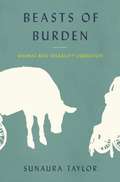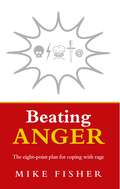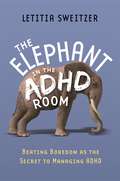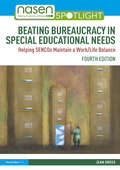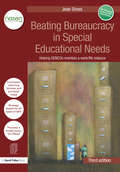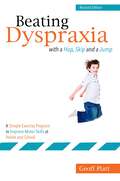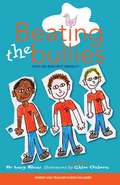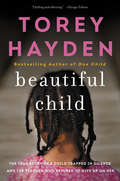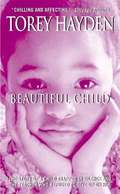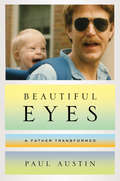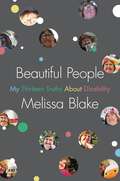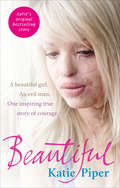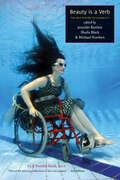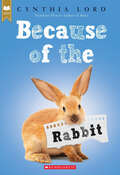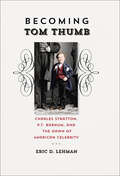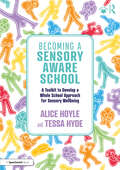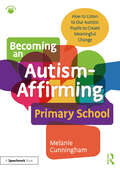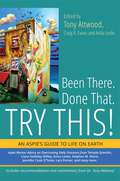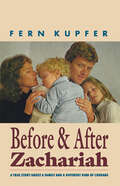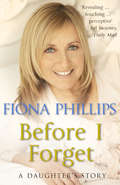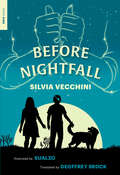- Table View
- List View
Beasts of Burden: Animal and Disability Liberation
by Sunaura TaylorA deeply provocative inquiry into the intersection of animal and disability liberation and the debut of an important new social critic How much of what we understand of ourselves as "human" depends on our physical and mental abilities how we move (or cannot move) in and interact with the world? And how much of our definition of "human" depends on its difference from "animal"? Drawing on her own experiences as a disabled person, a disability activist, and an animal advocate, author Sunaura Taylor persuades us to think deeply, and sometimes uncomfortably, about what divides the human from the animal, the disabled from the non-disabled and what it might mean to break down those divisions, to claim the animal and the vulnerable in ourselves, in a process she calls "cripping animal ethics." Beasts of Burden suggests that issues of disability and animal justice which have heretofore primarily been presented in opposition are in fact deeply entangled. Fusing philosophy, memoir, science, and the radical truths these disciplines can bring whether about factory farming, disability oppression, or our assumptions of human superiority over animals Taylor draws attention to new worlds of experience and empathy that can open up important avenues of solidarity across species and ability. Beasts of Burden is a wonderfully engaging and elegantly written work, both philosophical and personal, by a brilliant new voice.
Beating Anger: The eight-point plan for coping with rage
by Mike FisherWe all feel angry at times. It can be an uncomfortable emotion, yet it is almost a taboo subject. We get very little guidance in our culture on how to deal with it, and the guilt or violence that may accompany it. Here is the perfect book to help anyone from 16-75 years old to beat their anger - or help anyone else to do the same. Aimed at parents, families, young adults and teachers, social and youth workers, health care professionals, managers, customer service departments, psychotherapists and counsellors - there cannot be many men or women who have not felt uncomfortable when they are angry, and wondered what to do about it. The British Association of Anger Management (BAAM) is considered the leading specialist organization in the field. Founded by Mike Fisher in 2001, its mailing list reaches approximately 10,000 people a month and it receives enquiries from all over the world, and from all walks of life. Beating Anger is endorsed by BAAM, and used on all its anger management courses. It explains what anger is, what triggers it, the various different types of anger - and its substitutes - how to heal emotional aggression, and the 8 Golden Rules of Anger Management.
Beating Blindness: 11 Heart Moving Stories To Change Your Thinking
by Syed Shadab HusainA collection of 11 short inspiring stories of persons with visual impairment collected by described by Syed Shadab Husain.
Beating Boredom as the Secret to Managing ADHD: The Elephant in the ADHD Room
by Letitia SweitzerBoredom and boredom avoidance drive the behaviours of inattention, impulsivity, and hyperactivity - the diagnostic criteria of ADHD. This is the first ADHD resource to thoroughly explore the connection between the two. Full of innovative approaches, the book introduces a wide range of strategies for professionals working in clinical, educational and therapeutic settings to help those with ADHD beat boredom and engage with tasks and goals they want or need to achieve. Approaches specifically designed for toddlers, children, teenagers and adults are included, which can then be incorporated into schoolwork, jobs, relationships and everyday life. This practical resource will provide professionals who diagnose, treat, coach, and teach those with ADHD or those who suffer from frequent or pervasive boredom, with the tools to alleviate boredom in order to improve both concentration and mood.
Beating Bureaucracy in Special Educational Needs: Helping SENCOs Maintain a Work/Life Balance (nasen spotlight)
by Jean GrossAre you overwhelmed by the amount of paperwork that SEND generates in your school? Would you like to spend more time improving the quality of teaching and learning for pupils with SEN or disabilities? If so, this is an essential book for you. Beating Bureaucracy in Special Educational Needs shows how schools can tackle SEND bureaucracy by reducing the need for provision that is ‘additional to or different from’ that available to all pupils, through developing inclusive environments, curricula and teaching. This means placing fewer children on SEND registers and focusing SEND Code of Practice procedures squarely on those pupils with more complex needs. Fully revised and updated, the fourth edition of this bestselling, practical text demonstrates what can be achieved, with new case studies describing schools with outstanding SEND provision, inclusive teaching and successful partnerships with parents. The book also explores how SENCOs can effectively reduce their workloads by making the most of technology and by distributing responsibility to class and subject teachers and middle and senior leaders, rather than operating as a lone voice. A toolkit of ready-to-use proformas, also available as an online resource, includes: a model policy to give to Ofsted; information for parents, including the facts on ‘Velcro’ 1–1 support in the classroom; strategy sheets for all the main types of SEND; provision maps and proformas to help you plan, monitor and evaluate your provision. Full of helpful and achievable strategies, this book is an essential resource for school leaders, SENCOs and anyone undertaking national SENCO qualifications. It shows how to put responsibility for supporting children with additional needs firmly back where it belongs and will help you – in the words of one SENCO – ‘get your life back’.
Beating Bureaucracy in Special Educational Needs: Helping SENCOs maintain a work/life balance (nasen spotlight)
by Jean GrossAre you overwhelmed by the amount of paperwork that SEN generates in your school? Would you like to spend more time actually improving the quality of teaching and learning for pupils with SEN or disabilities? If so, this is an essential book for you. Fully revised and updated for the 2014 SEN Code of Practice, this new edition contains strategies for reducing the number of individual education plans and review meetings. Beating Bureaucracy in Special Educational Needs will help you to use existing systems for target setting, recording and planning – personalised systems that are used for all children as part of everyday teaching practices. It lists the intervention programmes that really work and showcases the work of four schools that have successfully developed ways of planning provision, working with parents, and supporting staff development. Ready-to-use proforma in the book are also available online, and include a model policy for Ofsted; strategy sheets for all main types of SEN; provision maps and proformas to help you plan, monitor and evaluate your provision Beating Bureaucracy in Special Educational Needs will provide support for school leaders, SENCOs and anyone undertaking the national SENCO award. A practical and engaging guide, this new and updated edition shows how to put responsibility for supporting children with most types of additional need firmly back where it belongs – with class and subject teachers. It will help you – in the words of one SENCO – ‘get your life back’.
Beating Dyspraxia with a Hop, Skip and a Jump: A Simple Exercise Program to Improve Motor Skills at Home and School Revised Edition
by Geoffrey PlattGeoff Platt's exercise program, tailored to help children with dyspraxia to overcome their symptoms, enjoy physical activities, and become as active as their friends and classmates, is now proven to be even more effective. This revised edition outlines the fun and easy-to-teach program, which focuses on familiar activities such as running, jumping and ball play, and explains how regular exercise routines can reduce weakness and improve motor skills, such as balance, timing and coordination. It includes extra session plans, incorporates new research, and adds a secondary stage to the exercise program, teaching the skills of praxis, planning movement and improving skills. This practical guide will be an essential resource for Physical Education teachers and non-specialist teachers of recreation and games classes who are looking to help children with dyspraxia to reduce weakness and improve motor skills, as well as parents.
Beating The Blues: New Approaches to Overcoming Dysthymia and Chronic Mild Depression
by Susan S. Lang Michael E. ThaseDiscusses what thysthemia is and what makes a person susceptible to mild ongoing depression. Also outlines various possibilities for ongoing coping, not all having to do with drugs and counseling.
Beating the Bullies
by Dr Lucy BluntBen is being bullied at school. Other boys shove him, call him names and leave him out of games. Who can help him? What can he do? One in five children are bullied at school. Bullying can be overt: physical and verbal, or covert: passive-aggressive and excluding. Bullying can create a legacy for life if no one intervenes. Beating the Bullies is a guide for 7-11 year old boys and girls written by Clinical Psychologist Dr Lucy Blunt. In the form of an innovative children's chapter book, it gives age-appropriate information aimed to "upskill" the child and give them "bully-proof strategies" for coping. Beating the Bullies also has two invaluable resource guides; one for parents (who often feel powerless and helpless at this time) and one for teachers (with class specific questions and activities). Illustrated by Dr Blunt's daughter, Chloe Osborn, Beating the Bullies is engaging and interactive and an essential resource to tackle the damaging and important issue of bullying.
Beautiful Child
by Torey HaydenMore than two decades ago, in her unforgettable international bestseller "One Child," author Torey Hayden chronicled her poignant struggle to help a severely troubled little girl. Over the ensuing years, this dedicated special education teacher has faced many other heartbreaking challenges -- and has never abandoned a child in need. Beautiful ChildSeven-year-old Venus Fox's unresponsiveness was so complete that Torey Hayden initially believed the child was deaf. Venus never spoke, never listened, never even acknowledged the presence of another human being in the room with her. Yet an accidental playground "bump would release a rage frightening to behold, turning the little girl into a whirling dynamo of dangerous malice. Of the five children in Torey's classroom that September, Venus posed the greatest challenge -- though the other four had serious problems of their own that could not be overlooked. The six-year-old twins Shane and Zane suffered from fetal alcohol syndrome and its accompanying mix of high agitation and low concentration. At nine, cocky, aggressive Billy had already been expelled from school twice. Eight-year-old Jesse suffered from Tourette's syndrome. And then there was Venus. Though all of the children had different needs and afflictions, they had two things in common: a profound, sometimes violent dislike of one another, and the desire to be almost anywhere other than Torey's class. The school year that followed would prove to be one of the m
Beautiful Child
by Torey HaydenFrom the bestselling author of One Child comes this amazing, true story of a mute and withdrawn seven—year—old girl and the special education teacher determined never to abandon a child in need.Seven-year-old Venus Fox never spoke, never listened, never even acknowledged the presence of another human being in the room with her. Yet an accidental playground “bump” would release a rage frightening to behold. The school year that followed would be one of the most trying, perplexing, and ultimately rewarding of Torey Hayden’s career, as she struggled to reach a silent child in obvious pain. It would be a strenuous journey beset by seemingly insurmountable obstacles and darkened by truly terrible revelations—yet encouraged by sometimes small, sometimes dazzling breakthroughs—as a dedicated teacher remained committed to helping a “hopeless” girl, and patiently and lovingly leading her toward the light of a new day.
Beautiful Child: The Story of a Child Trapped in Silence and the Teacher Who Refused to Give Up on Her
by Torey L. HaydenSeven-year-old Venus Fox never spoke, never listened, never even acknowledged the presence of another human being in the room with her. Yet an accidental playground "bump" would release a rage frightening to behold. The school year that followed would prove to be one of the most trying, perplexing, and ultimately rewarding of Torey's career, as she struggled to reach a silent child in obvious pain. It would be a strenuous journey beset by seemingly insurmountable obstacles and darkened by truly terrible revelations--yet encouraged by sometimes small, sometimes dazzling breakthroughs--as a dedicated teacher remained committed to helping "hopeless" girl, and patiently and lovingly leading her toward the light of a new day. A stunning and poignant account of an extraordinary teacher's determination never to abandon a child in need from the internationally bestselling author of ONE CHILD.
Beautiful Eyes: A Father Transformed
by Paul AustinThrough parenting a child with a disability, a father discovers patience, acceptance, and unconditional love. In 1987, Paul Austin and his wife Sally were newlyweds, excited about their future together and happily anticipating the birth of their first child. He was a medical student and she was a nurse. Everything changed the moment the doctor rushed their infant daughter from the room just after her birth, knowing instantly that something was wrong. Sarah had almond-shaped eyes, a single crease across her palm instead of three, and low-set ears--all of which suggested that the baby had Down syndrome. Beginning on the day Sarah is born and ending when she is a young adult living in a group home, Beautiful Eyes is the story of a father's journey toward acceptance of a child who is different. In a voice that is unflinchingly honest and unerringly compassionate, Austin chronicles his life with his daughter: watching her learn to walk and talk and form her own opinions, making decisions about her future, and navigating cultural assumptions and prejudices--all the while confronting, with poignancy and moving candor, his own limitations as her father. It is Sarah herself, who, in her own coming of age and her own reconciling with her difference, teaches her father to understand her. Time and again, she surprises him: performing Lady Gaga's "Poker Face" at a talent show; explaining how the word "retarded" is hurtful; reacting to the events of her life with a mixture of love, pain, and humor; and insisting on her own humanity in a world that questions it. As Sarah begins to blossom into herself, her father learns to look past his daughter's disability and see her as the spirited, warmhearted, and uniquely wise person she is.
Beautiful People: My Thirteen Truths About Disability
by Melissa BlakeWell-known disability activist and social media influencer Melissa Blake offers a frank, illuminating memoir and a call to action for disabled people and allies. In the summer of 2019, journalist Melissa Blake penned an op-ed for CNN Opinion. A conservative pundit caught wind of it, mentioning Blake&’s work in a YouTube video. What happened next is equal parts a searing view into society, how we collectively view and treat disabled people, and the making of an advocate. After a troll said that Blake should be banned from posting pictures of herself, she took to Twitter and defiantly posted three smiling selfies, all taken during a lovely vacation in the Big Apple:I wanted desperately to clap back at these vile trolls in a way that would make a statement, not only about how our society views disabilities, but also about the toxicity of our strict and unrealistic beauty standards. Of course I knew that posting those selfies wasn't going to erase the nasty names I'd been called and, the chances were, they would never even see my tweet, but that didn't matter. I wasn't doing it for them; I was doing it for me and every single disabled person who has been bullied before, online and in real life. When people mock how I look, they're not just insulting me. They're insulting all disabled people. We're constantly told that we're repulsive and ugly and not good enough to be seen. This was me pushing back against that toxic, ableist narrative.For the first time, I felt like I was doing something empowering, taking back my power and changing the story. Her tweet went viral, attracting worldwide media attention and interviews with the BBC, USA Today, the Chicago Tribune, PEOPLE magazine, Good Morning America and E! News. Now, in her manifesto, Beautiful People, Blake shares her truths about disability, writing about (among other things): the language we use to describe disabled people ableism, microaggressions, and their pernicious effects what it's like to live in a society that not only isn't designed for you, but actively operates to render you invisible her struggles with self‑image and self‑acceptance the absence of disabled people in popular culture why disabled people aren't tragic heroes Blake also tells the stories of some of the heroes of the disability rights movement in America, in doing so rescuing their incredible achievements from near total obscurity. Highlighting other disabled activists and influencers, Blake&’s work is the calling card of a powerful voice—one that has sparked new, different, better conversations about disability.
Beautiful: A beautiful girl. An evil man. One inspiring true story of courage
by Katie Piper'I heard a horrible screaming sound, like an animal being slaughtered ... then I realised it was me.'When Katie Piper was 24, her life was near perfect. Young and beautiful, she was well on her way to fulfilling her dream of becoming a model.But then she met Daniel Lynch on Facebook and her world quickly turned into a nightmare ...After being held captive and brutally raped by her new boyfriend, Katie was subjected to a vicious acid attack. Within seconds, this bright and bubbly girl could feel her looks and the life she loved melting away.Beautiful is the moving true story of how one young woman had her mind, body and spirit cruelly snatched from her and how she inspired millions with her fight to get them back.
Beauty is a Verb
by Sheila Black Jennifer Bartlett Michael Northen<b>Chosen by the American Library Association as a 2012 Notable Book in Poetry.</b> <P>Beauty is a Verb is a ground-breaking anthology of disability poetry, essays on disability, and writings on the poetics of both. Crip Poetry. Disability Poetry. Poems with Disabilities. This is where poetry and disability intersect, overlap, collide and make peace. <P> Sheila Black is a poet and children's book writer. In 2012, Poet Laureate Philip Levine chose her as a recipient of the Witter Bynner Fellowship. <P> Disability activist Jennifer Bartlett is a poet and critic with roots in the Language school. <P>Michael Northen is a poet and the editor of Wordgathering: A Journal of Poetics and Disability.
Beauty is a Verb: The New Poetry Of Disability
by Sheila Black Jennifer Bartlett Michael NorthenA ground-breaking anthology that will bring fresh understanding to the American experience of poetry, beauty, the body, and disability.Beauty is a Verb is a ground-breaking anthology of disability poetry, essays on disability, and writings on the poetics of both. Crip Poetry. Disability Poetry. Poems with Disabilities. This is where poetry and disability intersect, overlap, collide and make peace. For the reader of good poetry interested in the diversity of American expression, this anthology provides an understanding of the history and contemporary vitality of the poetry and poetics of the non-normative body.
Because of the Rabbit (Scholastic Press Novels Ser.)
by Cynthia LordOn the last night of summer, Emma tags along with her game warden father on a routine call. They're supposed to rescue a wild rabbit from a picket fence, but instead they find a little bunny. Emma convinces her father to bring him home for the night.The next day, Emma starts public school for the very first time after years of being homeschooled. More than anything, Emma wants to make a best friend in school. But things don't go as planned. On the first day of school, she's paired with a boy named Jack for a project. He can't stay on topic, he speaks out of turn, and he's obsessed with animals. Jack doesn't fit in, and Emma's worried he'll make her stand out.Emma and Jack bond over her rescue rabbit. But will their new friendship keep Emma from finding the new best friend she's meant to have? Newbery Honor-winning author Cynthia Lord has written a beautiful and sensitive book about being different and staying true to yourself.
Becoming Tom Thumb: Charles Stratton, P.T. Barnum, and the Dawn of American Celebrity (The Driftless Connecticut Series)
by Eric D. LehmanAn “evocative and entertaining” biography of the nineteenth century circus performer who became a global phenomenon (Neil Harris, author of Humbug).When P. T. Barnum met twenty-five-inch-tall Charles Stratton at a Bridgeport, Connecticut hotel in 1843, one of the most important partnerships in entertainment history was born. With Barnum’s promotional skills and the miniature Stratton’s comedic talents, they charmed a Who’s Who of the nineteenth century, from Queen Victoria to Charles Dickens to Abraham Lincoln. Adored worldwide as “General Tom Thumb,” Stratton played to sold-out shows for almost forty years. From his days as a precocious child star to his tragic early death, Becoming Tom Thumb tells the full story of this iconic figure for the first time. It details his triumphs on the New York stage, his epic celebrity wedding, and his around-the-world tour, drawing on newly available primary sources and interviews. From the mansions of Paris to the deserts of Australia, Stratton’s unique brand of Yankee comedy not only earned him the accolades of millions of fans, it helped move little people out of the side show and into the limelight.
Becoming a Sensory Aware School: A Toolkit to Develop a Whole School Approach for Sensory Wellbeing
by Alice Hoyle Tessa HydeSensory needs are often misunderstood and, as a result, neglected across many schools. Yet sensory needs are universal foundational building blocks at the base of both human and learning needs. This practical book covers everything schools need to know and consider about the sensory needs of all students and staff within the school environment. By focusing on all sensory needs in a holistic way, this leads to a deeper understanding of one another and is a truly inclusive approach to benefit all.Sensory Aware Schools have the potential for happier and more productive learning environments, with reduced potential for disruption as well as improvements in how school communities work and learn together. Chapters look at the sensory aware student and teacher and the sensory aware classroom and school, setting out the roadmap for working from sensory awareness to sensory inclusion and towards sensory wellbeing.The book:• Sets out the core and quality standards for Sensory Aware Schools• Provides a clear introduction to sensory systems and sensory awareness, discussing a variety of different models and approaches• Contains audit tools to help the reader to reflect on sensory needs, as well as a wealth of best practice tips, reflective questions and case studies• Develops staff skills in recognising and responding to sensory needs • Offers easy-to-implement, practical strategies for effective, short-term adjustments as well as long-term improvements to the sensory school environment• Includes an extensive sensory curriculum for students.This accessible book equips the reader with a multitude of strategies and resources and illustrates how adopting a whole school approach to sensory wellbeing will benefit everyone. It is essential reading for school leaders, Special Educational Needs and Disabilities Co-ordinators (SENDCOs) and primary and secondary teachers in mainstream or specialist provision, who are keen to develop an ethos of supporting sensory needs.
Becoming an Autism-Affirming Primary School: How to Listen to Our Autistic Pupils to Create Meaningful Change
by Melanie CunninghamThis accessible guide explores what an autism-affirming primary school should be like, from the perspective of autistic pupils, introducing a tool to gather pupil voice and sharing a toolbox of strategies informed and requested by autistic children themselves. The book presents a fun and engaging approach, the three houses, which can be used with autistic children to generate a greater understanding of how they are experiencing school and how they may be masking their difficulties.Chapters focus on common themes, from developing a shared, positive understanding of autism throughout the school, to consideration of the classroom environment, hidden support, homework and routines. By identifying simple adjustments to practice, schools can create a more positive experience for autistic children, building self-advocacy and helping to alleviate feelings of anxiety. The book includes a wealth of easy-to-implement, practical strategies that place an emphasis on whole-school approaches, as well as opportunities for readers to reflect on their current practice. Quotes from autistic children, describing their experiences, are woven throughout the book.Becoming an Autism-Affirming Primary School keeps the voices of autistic pupils at its core and is a valuable read for primary school teachers, SENCos and senior leaders to ensure they are offering much-needed support for autistic children, which will also be of benefit to their non-autistic peers. Parents may find it useful to generate an understanding of how their autistic children might be experiencing school and autistic children themselves may find the narrative from other autistic children valuable.
Been There. Done That. Try This!: An Aspie's Guide to Life on Earth
by Temple Grandin Tony Attwood Mary Robison Liane Holliday Willey Jeanette Purkis James Buzon Ruth Elaine Hane Stephen M. Shore Charlene Devnet Qazi Fazli Azeem Alexis Wineman Anita Lesko Debbie Denenburg Garry Burge Lars Perner Mitchell Christian Lisa Morgan Richard Stirling Maguire Steve Selpal Larry Moody Bob Castleman John Makin Henny Kupferstein Patrick V. Suglia Karen Krejcha Craig Evans Paul IsaacsIf you only buy one book to improve your life this year, make it this one. Temple Grandin, Liane Holliday Willey, Anita Lesko, Stephen M. Shore, and many other Aspie mentors, offer their personal guidance on coping with the daily stressors that Aspies have identified as being the most significant, in order of urgency - anxiety, self-esteem, change, meltdowns, depression, friendship, love, and much, much more. Based on years of personal experience, this book is packed with advice from Aspie mentors who have all been there and done that! World expert Dr. Tony Attwood rounds up each chapter with professional analysis and extensive recommendations. He includes essential information on destructive strategies that may look attractive, but that have counter-productive effects. Including full color artwork from Aspie artists showing visually how they interpret each stressor, this is THE inspirational guide to life for young adults, the newly diagnosed, and as a life-long reference for anyone on the spectrum - written by Aspies for Aspies.
Before & After Zachariah: A True Story About a Family and a Different Kind of Courage
by Fern KupferThe heart-wrenching story of one couple's courageous decision to have their severely brain-damaged son cared for in a residential facility.
Before I Forget
by Fiona PhillipsFiona Phillips is one of our best-loved television presenters. Well-known for being warm, chatty and down to earth, she attended her local comprehensive in Southampton before studying English in Birmingham. For over twelve years she presented GMTV, during which time she interviewed some of the most famous and influential people on the planet, from film stars to royalty, politicians to local heroes. But in August 2008 Fiona announced that she was to quit the job she loved, revealing that her father, Phil, had been diagnosed with Alzheimer's just a year after her mother had died of the same disease and that she had decided to devote more time to him and to her family. Before I Forget is a wonderfully honest account of growing up in the 1960s and 70s within a complex family. During her childhood her father could sometimes be distant and demanding which both saddened her and drove her to succeed, her mother always the devoted wife and the steady heart of the family. When Fiona lands the job at GMTV she revels in how proud they are of her achievement. When her mother and then her father succumb to Alzheimer's we share in Fiona's sadness as she movingly describes watching them fade away, one moment interviewing George Clooney the next taking a call from Pembrokeshire Social Services to say that her mother had wandered away from her care home.Before I Forget is an extraordinary book which will resonate with Fiona's millions of fans and the millions of people who day-by-day are going through, or have gone through, the same experiences.
Before Nightfall
by Silvia VECCHINIA moving tale about a brave hearing-impaired teen losing his vision, told through the perspective of his loving sister in poetry, prose, and the sign-language alphabet.Carlo is a teenager who happens to be hearing-impaired and can see only out of one eye. Now that eye is failing, and Carlo must have an operation to try to save his vision. His fierce and funny sister Emma, Carlo&’s closest companion, begins writing poems that express the fear she works hard to hide, while his seeing-eye dog Lulù remains steadfastly at his side. But even with the support and affection of his family, how can Carlo face such uncertainty? And what will happen if he can no longer communicate with them? Before Nightfall is a book about trust, imagination, empathy, and language, narrated through the poems Emma types and through prose passages told from multiple perspectives and illustrated with sign-language alphabet, drawn by the Italian artist Sualzo. Despite the immense challenges Carlo and Emma face, their story is one of hope and wonder.
